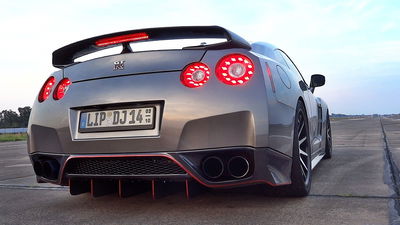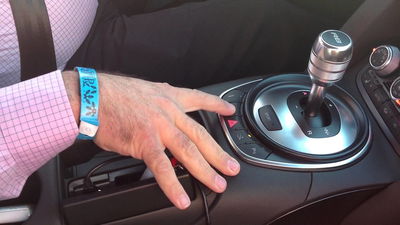Here's How Launch Control Works

Launch control is now a must in any serious performance car in production. Heck, even the current Renault Clio RS comes with a fully-functioning launch control system! Drag events are now full of supercars that appear to get the perfect launch time after time, leaving most manual clutch-dumpers in their wake.
Made famous by multiple videos online of Nissan GTRs sending people’s faces into serious levels of contortion, now nearly every supercar will come standard with a slightly different form of launch control each. So how do these systems work and how do they manage to accomplish near-perfect acceleration?
First of all, a launch control system has multiple jobs to complete to get a car off the line as efficiently and quickly as possible. It needs to eliminate wheel spin and hop, maximise useable power, weight transfer and traction and – in forced-induction powertrains – it has to build boost to a required level.
In the majority of cars, one has to engage a specific driver mode within the traction control settings to initiate launch control. Once the setting has been selected, the brake needs to be held down for a given time before the throttle can be floored. The rev counter then hits a predetermined limit, creating a spine-tingling rasp emanating from the exhaust. Then it’s up to you to step off the brake from which point the throttle is specifically applied to allow for the least amount of wheel spin and maximum acceleration.
Most of this performance trickery comes down to the programming within the cars ECU. The brake pedal effectively works as a trigger mechanism, with a sensor telling the ECU to engage the clutch to get the car going.
The car’s computer also will have a pre-set rev limiter which cuts ignition to ensure that the engine cannot reciprocate any higher. This limit has been calculated by the engineers who programmed the ECU, finding the maximum torque output through to the wheels that will make for the fastest acceleration.
You may presume that the car should simply be red-lined to initiate the fastest start possible, but when powertrains are creating as much torque as they do in the current crop of performance cars, the wheels would simply spin up and waste vital turning the tyres into molten rubber on the road surface. Most rev limiters therefore are set to around 3500-4500rpm, which will naturally dip slightly once the torque has been released to the wheels.
While that is all happening at the engine side of things, the transmission also has a big role to play to convert the fury under the bonnet to a ridiculous 0-60mph time. Dual-clutch transmissions are the norm when it comes to launch control systems, as they allow for more seamless and faster upshifts than a single clutch system. A wet dual-clutch also manages to cope well with the heat created by the torque inputs, allowing efficient heat transfer when using the correct transmission fluid, thus protecting the clutches and transmission from overheating. This makes the DCT capable of countless launches with no real danger of transmission warning lights!

The clutches within the DCT are ‘prepped’ to receive maximum torque once the brake is released, thus allowing for the exact torque output to reach the wheels as programmed into the ECU. The ABS system then comes into play – especially in all-wheel drive cars – braking whichever wheel is slipping to maximise traction. It is this computer trickery that makes for a much quicker launch than if you were to simply floor the throttle from zero revs, hoping for the best.
Although launch control has wormed its way into supercar spec sheets worldwide, it is most effective on those that are turbocharged or supercharged specifically. By allowing the engine to reach a rev limit at standstill, launch control systems allow a turbocharger to spool up in preparation for launch, thus allowing for a much higher power output from the engine than from a regular launch. This however should not be confused with turbocharger anti-lag which essentially creates small explosions in the exhaust system just ahead of the turbocharger to keep it spooled.
Although launch control is an extremely effective way of launching a car, it has to be said that the art of launching a car manually is completely eradicated from the driving experience. So although your quarter-mile time may be better and your tyres saved, it takes away a large part of petrolhead motoring that many of us will savour. Would you be happy with a launch control system on your car? Or are you much happier balancing that clutch drop yourself and hooking up the engine and transmission in perfect harmony?
Comment below with your thoughts!













Comments
0-100 reo kwik
Correction : magic happens and you just go like hell.
Correction : Witchcraft happens and you go faster.
Coming up,
How Drift Mode works!
Step 1 - buy Mustang.
Step 2 - Drift Mode spontaneously happens.
“Tech” writers on this site really have no clue about dual clutch transmissions do they? First the one the other week - including the crap about wet clutches - and now this BS about it being wear related?
Dual clutch transmissions have NOTHING TO DO WITH WEAR. They are only there so the next gear shaft can be preselected to reduce the drop in torque delivery by slipping them against each other whilst changing gear. It’s for faster, smoother shifts, nothing else.
Also, in turbocharged cars anti-lag techniques are very often used as well as just ignition cut to help with initial turbo spool, so there are elements of both going on (in fact random ignition retardation is often used even in N/A cars with launch control so the ECU can blend more advance back in to prevent the RPM drop when the clutch engages without the harshness of just releasing the ignition cut/hard limiter)
Technically speaking, you’re right. I sure may be a 14 year old but that doesn’t mean I don’t know how clutches work. Let’s think of it this way. A clutch is a maid. With one maid, you grt things done. If ya try to get the maid to do it fast and a lot, it’ll go down in quality. With 2 or 3 maids, it gets done faster snd in turn, more efficently.
Exactly finally someone i can agree with
Thanks Phillip, what I meant was the DCT systems cope better with the heat transfer from changing torque inputs, along with smoother shifts which reduce the strain on the transmission. Good to know you’re keeping me on my toes!
how about control launch ?
That’s when you do it yourself with a manual transmission
How I launch my ‘79 Beetle:
This deserves to be top comment, thank you fellow petrolhead for making me laugh😂
Ksi should read this so he stops losing to a Huracan.
so its basically traction control with vtec
hahah
Launch Control can be enabled by software on any Audi/Skoda/VW/Seat car with DSG gearbox.
Pagination